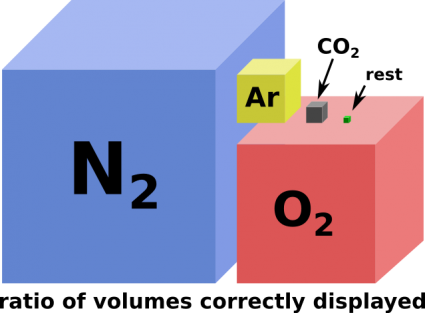Carbon dioxide collector
This page is about devices for the extraction of carbon dioxide from the atmosphere. The prime focus is earth's atmosphere.
Two motivations must be separated:
- greenhouse gas reduction
- carbon extraction for productive use
Solar powered carbon dioxide collectors have the potential to fulfill the global energy needs and remove the excess CO2 that had accumulated due to burning of fossil fuels along with other unwanted gases of industrial origin.
Contents
[hide]About the optimal size of devices
Devices for the removal of CO2 from the atmosphere do not need and probably should not be able to do self replication. Making such devices macroscopic seems to be a better alternative than making them in the micro- to nanoscale. Big devices:
- can work more efficient -- just like pants pocket sized nanofactories can operate much more efficient than ultra compact (sub microscale) molecular assemblers
- are obviously easier to handle (even collectible by hand)
- are less problematic in regards to environmental spill
Side-notes:
- Every conscientiously designed mobile (airborne/seaborne) device must care about its fate after their end of service.
- Carbon extraction must stop at a certain level - otherwise all plants on earth may be in severe danger of CO2 starvation.
Medium
Sub-classes:
- stationary carbon dioxide collectors (see section "Land" below)
- mobile carbon dioxide collectors
Locating solar cells for CO2 recuperation sparsely distributed in the air or on the sea instead of placing them concentrated in one place on the ground may be good for environmental (no pave-over) and political reasons.
Land (more or less stationary)
Nanofactories may use air directly as a building material.
The filtering system may be more or less integrated (more or less detachable).
Speedier operation without loss of efficiency needs bigger filter systems that are less likely to be directly integrated.
Going from fully integrated to "fully" separated one could imagine: just two ports then a flap on a hinge then separable devices connected with a "cable".
The extreme case would be global distances between carbon dioxide collection and carbon consumption. This goes a bit against "material deglobalisation" which is one of the main benefits of advanced atomically precise manufacturing technology. So one might avoid long range carbon dioxide (or carbon) transport for small scale low throughput applications like mechanosynthesis of cloths. Long range material transport may be more sensible for e.g. the fast erection of large scale structures like whole cities.
For the extreme case of global distances a global infinitesimally bearing tube mail capsule transport (alongside a Global microcomponent redistribution system) could be envisioned. The transportation of other building materials (like e.g. titanium, aluminum and silicon) that are not present in the air and need to be mined from solid material would benefit from such a system anyway.
Fully consumer-device detached collectors-devices have been proposed that feature a structure that makes them look slightly akin to trees.
(TODO: what are the benefits of this shape vs flat solar cells)
Placement in inhabited areas - environmental issues!
(wiki-TODO: find and link existing paper)
Water (seaborne)

Seaborne mobile carbon dioxide collector buoys of a size that is easy to handle. Swimming units have the benefit of easier access to wind power and easier propulsion. They can easily be kept stationary. They need only plain air as lifting medium can use the wind for propulsion and are easier to collect manually (skimming) if something goes wrong.
Air (airborne)
Micro airships: Mobile carbon dioxide collector balloon
- have a very lightweight bubble as main body in a size range between 10um and 100.000um
- use depending on size thermal heating or hydrogen for lift
- use their surface for harvesting of solar energy
- are capable of water capture and splitting for compensation of hydrogen diffusion loss
- may be capable of carbon dioxide capture and splitting
- may be capable of self replication
- may (if malicious) create some nasty gases
Extraterrestrial application
- usage on Venus
- usage in Gas giant atmospheres
Questions
- packing and shipping CO2 or preprocessing it right away?
To investigate: If replicative how fast could they replicate (doubling time) depending on their diameter?
What is the limiting factor: solar-power for hydrogen generation, diluteness of CO2 or something else?
To investigate: Can they be made to actively propel themselves? Their high volume to mass ratio makes this rather difficult when there's even the slightest bit of wind. Flattening the bubbles drops the aerodynamic resistance significantly.
To investigate: AP manufactured solar cells & mechanosynthetic carbon dioxide splitting
Related
- Mobile in general: Mobile carbon dioxide collector
- Seaborne: Mobile carbon dioxide collector buoy
- Airborne: Mobile carbon dioxide collector balloon
- Mechanosynthetic carbon dioxide splitting
- Air as a resource
- Mining with gem-gum-tec
- Carbon sequestration
- Josh Hall's high altitude mirror bubble concept (not necessarily handling atmospheric gasses) [todo: add video link]
- Mobile mesoscale robotic devices "nanobots"
- Mobile nanoscale robotic devices "microbots"
- atmosphere sentinels
- large scale storage of carbon dioxide (side-note: collection and storage together make "sequestation")
- Large scale construction
External Links
- Diamond Trees (Tropostats): A Molecular Manufacturing Based System for Compositional Atmospheric Homeostasis - 2010 Robert A. Freitas Jr. pdf
- Video: "Tropostats: Nanotechnology Harnessing Photosynthesis" (very conceptual)
[todo: split off macro and self replicating aspect from this page - distribute to sub-pages of Mobile robotic device ] [todo: tackle size and mobility decisions ] - done?

